The Qualcomm Snapdragon 820 Performance Preview: Meet Kryo
by Ryan Smith & Andrei Frumusanu on December 10, 2015 11:00 AM EST- Posted in
- SoCs
- Snapdragon
- Qualcomm
- Snapdragon 820
GPU Performance
Shifting gears, let’s take a look at GPU performance. As we mentioned earlier, Qualcomm isn’t disclosing much about this GPU other than that it packs quite a bit more computational power than its predecessor and should be quite a bit faster in the process. This points to a potentially significant architectural shift, but that determination will have to wait for another time.
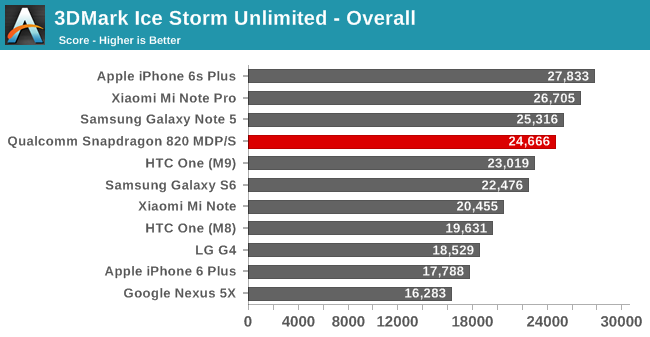
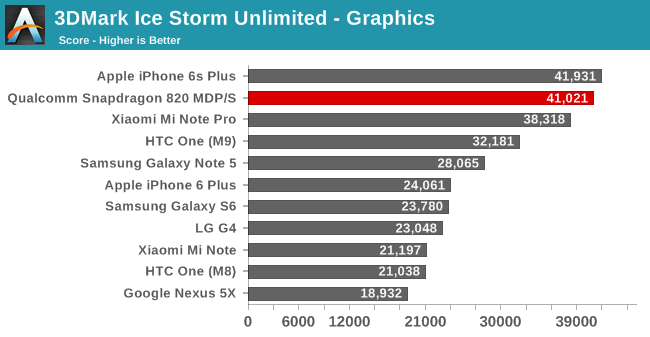
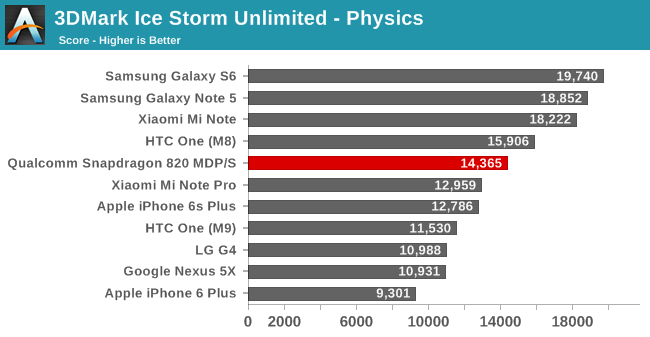
Starting with 3DMark Ice Storm Unlimited, the performance honestly doesn’t start out great. The overall score is significantly influenced by the physics score, which in turn is more concerned with the number of cores and their throughput on simple code than the ability to extract complex IPC. As a result the 4 CPU core 820 simply can’t catch up with the likes of the Samsung devices and their high-clocked big.LITTLE configurations. On the other hand the graphics score makes this the fastest Android phone to date, though relative to the 810 Mi Note Pro, perhaps not by a ton. Ultimately as this is an OpenGL ES 2.x test it’s not the most strenuous of tests these days, and comments from Qualcomm indicate that it may be a CPU-limited test on 820.
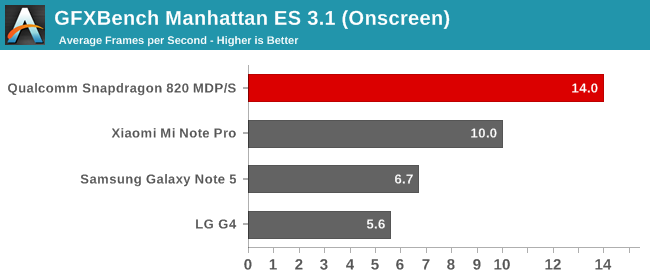
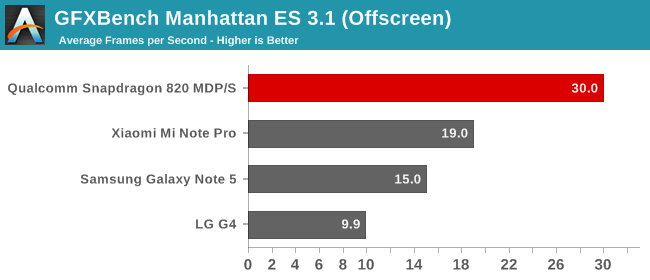
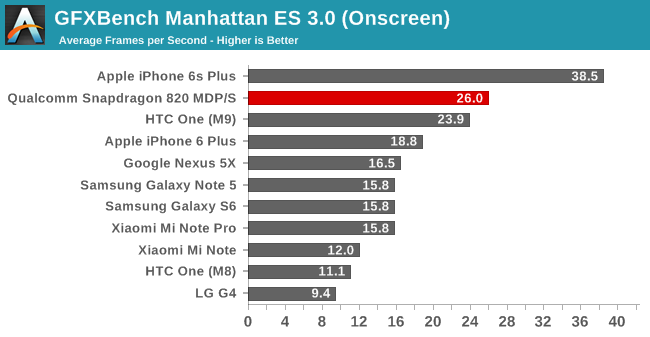
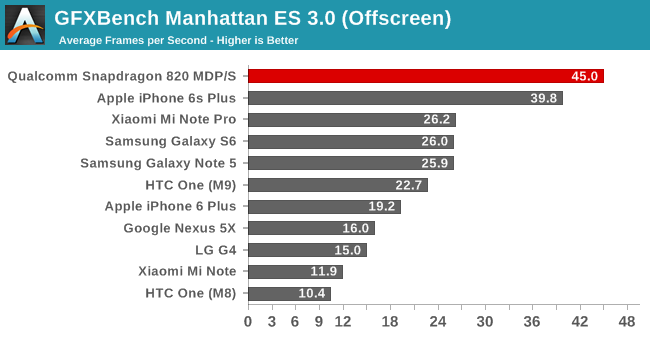
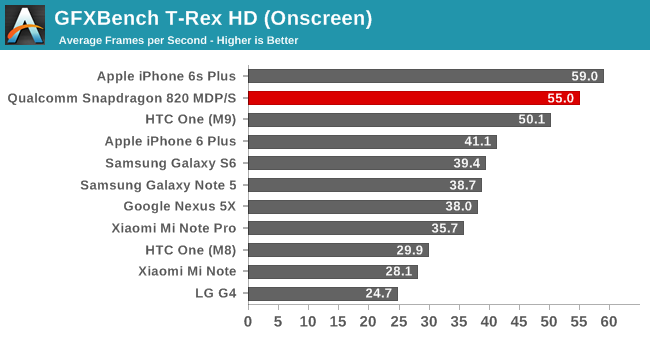
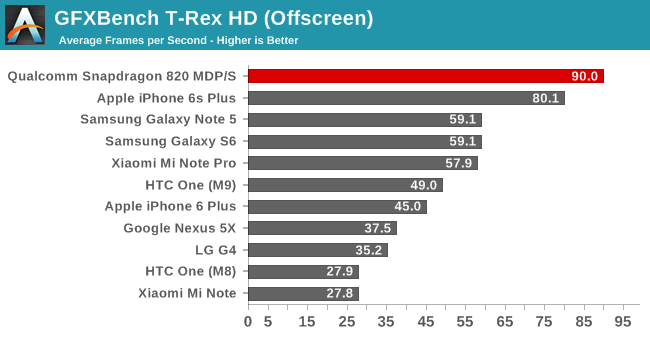
GFXBench on the other hand shows some massive gains for the 820 relative to any other Android device. In offscreen rendering mode, all 3 game tests – Manhattan ES 3.1, Manhattan ES 3.0, and T-Rex HD – put the 820 MDP/S as being 52% (or more) faster than the next-fastest Android device, either the 810 based Mi Note Pro or the Exynos 7420 based Samsung Galaxy Note 5. The single biggest jump we see is with Manhattan ES 3.0 at 72%, while the ES 3.1 version dials that back down to 52%. Even the iPhone 6s Plus, well known for its powerful GPU, is handily and consistently surpassed by the 820 here. Only due to the 6s Plus’s lower rendering resolution of 2208x1242 does it surpass the MDP/S in onscreen tests, as the latter needs to render at 2560x1600 (~50% more pixels). Qualcomm was aiming for some big GPU performance gains here and so far they are delivering.

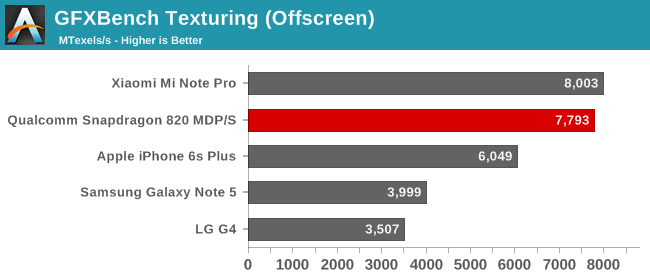
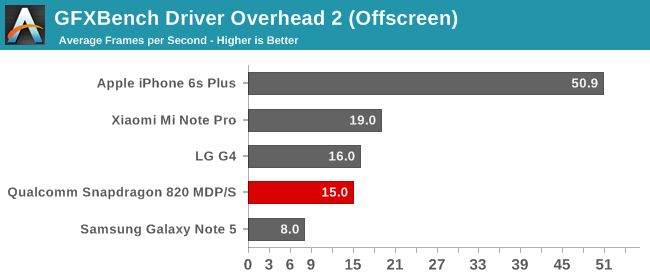
Curiously, GFXBench’s synthetic feature tests don’t show the same gains. Offscreen ALU performance is only slightly improved over the 810 (10%) or in the case of texturing is an outright regression. None-the-less full gaming performance is clearly in the 820’s favor. I’ve long suspected that the Adreno 430 GPU in the 810 had some kind of architectural bottleneck – perhaps an ALU/texture array that was difficult to fully utilize – and what we’re seeing here would back up that claim, as if that was the case then correcting it would have allowed Qualcomm to significantly boost their rendering performance while only barely changing their synthetic performance. Otherwise I find it a bit surprising that the driver overhead score is a bit worse on 820 than 810, which may be a result of the immature GPU drivers on this early device.










146 Comments
View All Comments
lilmoe - Friday, December 11, 2015 - link
He's not talking about clock speeds. He's talking about the whole package. Samsung has lots more experience with big.LITTLE and their implementations are far superior than competing chips on the SAME process node. Both the Exynos 5433 and the Snapdragon 808 are built on 20nm, yet the Exynos performs AND sustains its performance better than the Snapdragon.testbug00 - Sunday, December 13, 2015 - link
yes, Qualcomm's memory controller was busted. Doesn't make the A57 core any better.It's a pretty bad core compared to just about everything else ARM offers currently. A7, A9, A12/17, A53, A72. All far superior to the A57 overall.
tipoo - Thursday, December 10, 2015 - link
On Samsungs 14nm process, yeah they ran ok. But it effectively cancelled out a generation's worth of fabrication process advantage, just to be able to run the things without throttle hell.melgross - Thursday, December 10, 2015 - link
This should be interesting. Phones delivering this chip will be seen, mostly, during the April-May period. That leaves them about 4 months, on average, before the iPhone 7 with the new A10 comes out. With this behind the A9 in many areas, that doesn't give them much leeway in performance or time.So most of the year leaves Apple's chips basically unchallenged. It seems to me that shipping schedules for flagship Android phones needs to shift, along with the release of high end SoCs to more closely match Apple's release dates, or there will always be this disparity.
While it's often said that Android phone manufacturers are competing against one another more than they are competing against Apple, that's only true because they have a hard time competing against Apple at the higher end. Having phones that better compete in performance on the same release schedule would help somewhat.
This chip really needed to come out last August, not next spring.
Refuge - Friday, December 11, 2015 - link
I disagree, they have no problem competing with Apple at the high end. They won me easily.The A9 is a nice chip, but running iOS its like having Camaro SS with a limiter set at 75mph.
I'm sorry, I just can't and won't consider the two eco-systems in any way similar. People buy the OS first and the device second. Like iphone, but want an android OS? Someone has an iPhone clone out right now just for you.
mdriftmeyer - Friday, December 11, 2015 - link
Wow. The voice of one dot speaking against reality. Apple's SoC designs and implementations are only expanding their leads on the competition. That ecosystem they also dominate in is building ever greater loyalty: they deliver and the software matches the hardware.Move along and hope for the future.
mdriftmeyer - Friday, December 11, 2015 - link
Above comment should have embedded below Refuge.bug77 - Thursday, December 10, 2015 - link
Nice preview, but, as it happens lately, what matters more is sustained performance, not some burst numbers during a single benchmark run.jjj - Thursday, December 10, 2015 - link
Interesting that they seem to be going with a small cache and the memory score is rather nuts for just 2x32bit."And though one could have a spirited argument about whether single-threaded or multi-threaded performance is more important, I’m firmly on the side of ST for most use cases."
Do note that SD820 has 2 cores clocked lower, it's not just 4 vs 8, it's 4+4 vs 2+2. Everybody in the dumb press will be tempeted to forget that 2 cores are clocked lower here .
As for ST perf , the thing is that at this perf level ST is more than enough so it loses relevance. Would be nice if you guys would compare ST perf with Nehalem and newer desktop cores.
Anyway, it blows that you insist on using the same empty synthetic benchmarks that have no relevance at all. SPECint2000 and Geekbench are fine but all else is irrelevant.
"Where the 820 MDP/S makes up for it is in the photo editing score, which is through the roof. Here Qualcomm’s development device holds a 34% performance lead over the next-fastest device, the 810/A57 based Mi Note Pro."
So using the GPU or DSP? If so , is it cheating or (all) actual apps will use the GPU/DSP too, as they should. How about the behaviour of all other SoCs. Long live synthetic! It's like begging them to cheat....
"Apple’s commanding lead in ARM CPU performance."
How is that exactly? Have you actually done any math , at the very least at equal per core power? In die area Apple is far behind but you don't like that being mentioned.
In Geekbench Apple does 2.5k in each of the 3 segments, Kryo does about 2.1k in FP and integer and well over 3k in memory. So 20% higher clocks could eneble Kryo to match Apple's core in FP and integer. It's not impossible that in a dual core config Kryo could clock 20% higher. Same for A72. In the end if MTK can clock 2xA72 at 2.5GHz on 20nm, they could do much better on 16ff+. In theory 16ff+ can provide up to 40% higher speed over 20nm but only some 30% is needed. Ofc A72 is also much much smaller than Apple's core and you can actually make a cheap SoC with it for 150$ phones.
vs A72 ,it's hard to assume things. If A72 goes to 2.5 GHz in quad config and matches the SD820 in power ,then it's somewhat even and not really.
In Geekbench Kryo at 2.15 vs A72 at 2.5Ghz should be about even in integer with Kryo having some 10% lead in FP but Kryo would be at higher per core power.
You got core 3 and 4 at likely half the power (or even less) at max load, so total power is like having 3 cores at max clocks. Folks could do that with A72 too.
Ofc remains to be seen if A72 can reach 2.5GHz or even more with fewer cores and how everybody does in power.
Will be very interesting to see Kryo in server. Assuming it will be a slightly tuned Kryo and not something very different.
A72 does enable others to provide a multitude of configs in different price ranges and that could be interesting. Just today a Xiaomi device showed up in Geekbench with SD618 and just 2GB of RAM. 2GB of RAM would be too little for anything above Redmi 3 and Redmi 3 couldn't be priced above 699CNY (109$). Sure it would be dual A72 at low clocks on 28nm but it's a start.
tipoo - Thursday, December 10, 2015 - link
You're assuming it will happily clock 20% higher with no disproportionate power draw increases. This is what Qualcomm provided, so it only makes sense for the reviewer to test it as they got it, rather than speculating on what it would be while higher clocked.I don't see how Apples die area matters to an end user. The cost is spread through the entirety of the product, they are premium products, but really all that matters in the end to a user is performance and battery life.